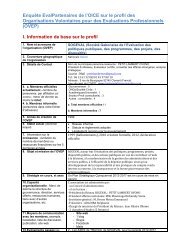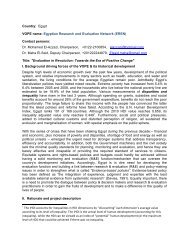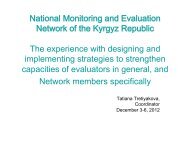The Program Evaluation Standards in International Settings
The Program Evaluation Standards in International Settings - IOCE
The Program Evaluation Standards in International Settings - IOCE
Create successful ePaper yourself
Turn your PDF publications into a flip-book with our unique Google optimized e-Paper software.
22 Sandy TautIn this context, research as a communicative process becomes highly relevant. Evaluatorsneed to pay attention to cultural differences <strong>in</strong> the nature of knowledge (as a group rather than an<strong>in</strong>dividual notion <strong>in</strong> collectivist societies), the right to op<strong>in</strong>ions (only group leaders and elders asbe<strong>in</strong>g legitimate op<strong>in</strong>ion holders <strong>in</strong> collectivist societies), the expectations toward theconstruction of <strong>in</strong>terviews and surveys, <strong>in</strong>group versus outgroup dichotomies, sex and agefactors (see Berry et al., 1997, Vol. 1, chapter 8, for further elaboration).It is beyond the scope of this paper to deal with issues of cross-cultural applicability ofresearch methodology <strong>in</strong> more depth. Regardless of the difficulties evaluators face when try<strong>in</strong>gto comply with the Accuracy <strong>Standards</strong>, they seem to mostly conta<strong>in</strong> goals for evaluatorsacceptable across cultures. However, further <strong>in</strong>vestigation needs to address (1) what isconsidered accurate <strong>in</strong>formation <strong>in</strong> different cultures (i.e., what is considered ‘valid,’ ‘reliable,’and ‘systematic’) and (2) how emphasis on either qualitative or quantitative methodologicalapproaches relates to cultural values.A2 Context Analysis <strong>The</strong> context <strong>in</strong> which the program exists should be exam<strong>in</strong>ed<strong>in</strong> enough detail, so that its likely <strong>in</strong>fluences on the program can be identified.Besides these general, admittedly sometimes speculative concerns, the Accuracy<strong>Standards</strong> as goals for proper conduct seem to be cross-culturally transferable. Nevertheless, afew relevant comments will be shared. Standard A2, Context Analysis, creates problems <strong>in</strong> thosecultural sett<strong>in</strong>gs where some context <strong>in</strong>formation, e.g., on the political and organizational contextof the program be<strong>in</strong>g evaluated, is hard to obta<strong>in</strong> and to share because of hierarchical concernsand strong group ties. On the other hand, high-context cultures which place emphasis onsituational (contextual) <strong>in</strong>formation for attributional and judgmental processes will especiallyvalue Context Analysis as part of an evaluation (Berry et al., 1997, Vol. 3, chapter 3, p. 53).A11 Impartial Report<strong>in</strong>g Report<strong>in</strong>g procedures should guard aga<strong>in</strong>st distortioncaused by personal feel<strong>in</strong>gs and biases of any party to the evaluation, so thatevaluation reports fairly reflect the evaluation f<strong>in</strong>d<strong>in</strong>gs.In addition, Standard A11, Impartial Report<strong>in</strong>g, conta<strong>in</strong>s non-universal cultural values;the analyses given for <strong>Standards</strong> U5, P6 and P7 apply to this Standard.






